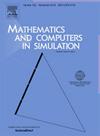The adiabatic exponential limits of Riemann solutions in the isentropic three-component model
IF 4.4
2区 数学
Q1 COMPUTER SCIENCE, INTERDISCIPLINARY APPLICATIONS
引用次数: 0
Abstract
The explicit construction of Riemann solutions is achieved for an ideally isentropic three-component model owning a unitary velocity and a collective pressure in one space dimension under the hypotheses without mass and heat transfer and also without viscosity. In addition, the asymptotic results of Riemann solutions are explored at length by sending the adiabatic exponent drop to one. On the one side, it reveals the concentration phenomenon, where the Riemann solution with a 1-shock, 2,3-contact and 4-shock waves converges to a delta shock solution. On the other side, it also exhibits the cavitation phenomenon, where all internal states in the 1-rarefaction and 4-rarefaction waves become vacuum ones by sending this limit. Finally, some representative numerical simulations are offered to observe the formation of delta shock wave and vacuum state in a more intuitive way as the adiabatic exponent tends to one, which is consistent with the theoretical analysis.
等熵三分量模型中Riemann解的绝热指数极限
在无质量、无传热、无粘度的假设下,实现了理想等熵三分量模型的黎曼解的显式构造,该模型具有一维空间的统一速度和集体压力。此外,通过将绝热指数降为1,详细探讨了黎曼解的渐近结果。一方面揭示了一激波、二激波、三接触激波和四激波的黎曼溶液收敛为δ激波溶液的集中现象。另一方面,它也表现出空化现象,通过发送这个极限,1-稀薄波和4-稀薄波的所有内部状态都变成了真空状态。最后,给出了一些有代表性的数值模拟,在绝热指数趋近于1时,更直观地观察了三角洲激波的形成和真空状态,与理论分析一致。
本文章由计算机程序翻译,如有差异,请以英文原文为准。
求助全文
约1分钟内获得全文
求助全文
来源期刊

Mathematics and Computers in Simulation
数学-计算机:跨学科应用
CiteScore
8.90
自引率
4.30%
发文量
335
审稿时长
54 days
期刊介绍:
The aim of the journal is to provide an international forum for the dissemination of up-to-date information in the fields of the mathematics and computers, in particular (but not exclusively) as they apply to the dynamics of systems, their simulation and scientific computation in general. Published material ranges from short, concise research papers to more general tutorial articles.
Mathematics and Computers in Simulation, published monthly, is the official organ of IMACS, the International Association for Mathematics and Computers in Simulation (Formerly AICA). This Association, founded in 1955 and legally incorporated in 1956 is a member of FIACC (the Five International Associations Coordinating Committee), together with IFIP, IFAV, IFORS and IMEKO.
Topics covered by the journal include mathematical tools in:
•The foundations of systems modelling
•Numerical analysis and the development of algorithms for simulation
They also include considerations about computer hardware for simulation and about special software and compilers.
The journal also publishes articles concerned with specific applications of modelling and simulation in science and engineering, with relevant applied mathematics, the general philosophy of systems simulation, and their impact on disciplinary and interdisciplinary research.
The journal includes a Book Review section -- and a "News on IMACS" section that contains a Calendar of future Conferences/Events and other information about the Association.
 求助内容:
求助内容: 应助结果提醒方式:
应助结果提醒方式:


